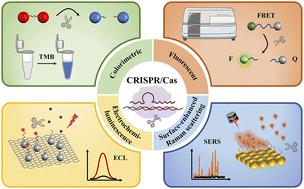当前位置:
X-MOL 学术
›
Anal. Methods
›
论文详情
Our official English website, www.x-mol.net, welcomes your
feedback! (Note: you will need to create a separate account there.)
Recent progress on the CRISPR/Cas system in optical biosensors
Analytical Methods ( IF 2.7 ) Pub Date : 2024-01-23 , DOI: 10.1039/d3ay02147e Bingqian Li 1 , Guangyu Zhai 2 , Yaru Dong 2 , Lan Wang 1 , Peng Ma 3
Analytical Methods ( IF 2.7 ) Pub Date : 2024-01-23 , DOI: 10.1039/d3ay02147e Bingqian Li 1 , Guangyu Zhai 2 , Yaru Dong 2 , Lan Wang 1 , Peng Ma 3
Affiliation

|
Clustered regularly interspaced short palindromic repeats (CRISPR) and CRISPR-associated (Cas) protein systems are adaptive immune systems unique to archaea and bacteria, with the characteristics of targeted recognition and gene editing to resist the invasion of foreign nucleic acids. Biosensors combined with the CRISPR/Cas system and optical detection technology have attracted much attention in medical diagnoses, food safety, agricultural progress, and environmental monitoring owing to their good sensitivity, high selectivity, and fast detection efficiency. In this review, we introduce the mechanism of CRISPR/Cas systems and developments in this area, followed by summarizing recent progress on CRISPR/Cas system-based optical biosensors combined with colorimetric, fluorescence, electrochemiluminescence and surface-enhanced Raman scattering optical techniques in various fields. Finally, we discuss the challenges and future perspectives of CRISPR/Cas systems in optical biosensors.
中文翻译:

CRISPR/Cas系统在光学生物传感器中的最新进展
成簇规则间隔短回文重复序列(CRISPR)和CRISPR相关(Cas)蛋白系统是古细菌和细菌特有的适应性免疫系统,具有靶向识别和基因编辑的特点,可抵抗外来核酸的入侵。与CRISPR/Cas系统和光学检测技术相结合的生物传感器以其良好的灵敏度、高选择性和快速的检测效率在医学诊断、食品安全、农业进步和环境监测等领域受到广泛关注。本文介绍了CRISPR/Cas系统的作用机制以及该领域的进展,总结了基于CRISPR/Cas系统的光学生物传感器结合比色、荧光、电化学发光和表面增强拉曼散射光学技术在各个领域的最新进展。字段。最后,我们讨论了 CRISPR/Cas 系统在光学生物传感器中的挑战和未来前景。
更新日期:2024-01-23
中文翻译:

CRISPR/Cas系统在光学生物传感器中的最新进展
成簇规则间隔短回文重复序列(CRISPR)和CRISPR相关(Cas)蛋白系统是古细菌和细菌特有的适应性免疫系统,具有靶向识别和基因编辑的特点,可抵抗外来核酸的入侵。与CRISPR/Cas系统和光学检测技术相结合的生物传感器以其良好的灵敏度、高选择性和快速的检测效率在医学诊断、食品安全、农业进步和环境监测等领域受到广泛关注。本文介绍了CRISPR/Cas系统的作用机制以及该领域的进展,总结了基于CRISPR/Cas系统的光学生物传感器结合比色、荧光、电化学发光和表面增强拉曼散射光学技术在各个领域的最新进展。字段。最后,我们讨论了 CRISPR/Cas 系统在光学生物传感器中的挑战和未来前景。































 京公网安备 11010802027423号
京公网安备 11010802027423号